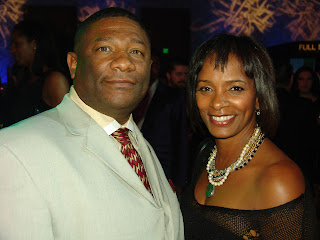The Star's are bright around "Tha Bishop from Compton" The Honorable Ombudsman General and Bishop L.J. Guillory.
Bishop Guilllory, who was the fall guy for the biggest city of Compton Corruption taken down by the Federal Government the 90's has wrote the best seller "I Know Why The Caged Lion Roars".
The Bishop's Book is now becoming a movie and it seems that the star's are in line to support what is quickly becoming an Oscar Buzz. The Vets in the Movie Business know which projects will have the funding to promote new movies and get good reviews at the Box Office, longer playing time in theaters, and most paramount heavyweights Producers, Directors, Actress/Actors.
Getting your project in the hands of Jude Law, Oprah Winfrey, Scarlett Johansson is only the start, there is a lot of work that has to be done once the light is on your project. And, its always nice to have great friends in the business that will fight for you all the way! Celebrities have a way of helping when it comes to the Oscar Predictions.
Bishop Guillory, like Rubin 'Hurricane' Carter was wrongfully convicted in a Corrupt Court of Law. And, only after fighting the system from within did the Bishop ever see the Light of Justice. I Know Why The Caged Lion Roars, will make you laugh, cry, and even get outraged with the system that sends so many of our young innocent black men to prisons throughout this nation.
What started out as a Documentary has become a full 120 minute movie. "I just want people understand what really happens when you take a young 23 year old and wrongfully convict him. Send him to the most odious place in the world "prison' and say fight for your life if you want to some day go home! said, Bishop L.J. Guillory.
The movie starts off in the city of Compton In the early 1990s, United States Attorney Joey Chin conducted a series of investigations, centered on a phony waste-to-energy scheme, that ultimately ensnared a number of prominent elected officials. A Compton Police Department internal affairs investigation report from 1999—just obtained by The Compton Bulletin—reveals that corruption within the department’s narcotics unit was identified in the months leading up to its eventual demise. The nearly 100-page report details an investigation that was launched shortly after Chief Hourie Taylor and Capt. Percy Perrodin were placed on administrative leave.
While Taylor was removing his personal belongings from the station, two of four kilos of cocaine that had been seized in a case dating back to 1992 and should have already been destroyed were found in a drug vault locker in which Taylor had indicated he might have personal belongings. Besides highlighting poor oversight and a slew of deficiencies and improprieties stemming from the absence of rules and regulations over the narcotics unit, the investigation revealed that three kilograms of cocaine were either stolen or lost from the department’s narcotics vault. The missing drugs had a street value of roughly $51,000.
Also probed was the alleged release of 60 kilograms of cocaine seized on April 23, 1997, to the FBI, which the investigators had been unable to verify as of the more than month-long investigation’s conclusion.
The movie takes you right on the Prison yard where Guillory and other African-American and Mexican-American Prisoners where pitted to Gladiator Fights. Front-page article by Mark Arax in the August 1996 Los Angeles Times claimed that CORCORAN STATE PRISON was "the most troubled of the 32 state prisons." At the time, CORCORAN PRISON officers had shot and killed more inmates "than any prison in the country" in CORCORAN's eight years of existence; based on interviews and documents, Arax concluded that many shootings of prisoners were "not justified" and that in some cases "the wrong inmate was killed by mistake." Furthermore, the article alleged that "officers... and their supervisors staged fights between inmates" during "gladiator days."
In November 1996, CBS Evening News broadcast "video footage of an inmate fatally shot by guards" at CORCORAN in 1994; this death "spawned a probe by the Federal Bureau of Investigation of alleged inmate abuses by guards." Bishop Guillory, was taken out of the Corcoran State Prison and was placed in federal Custody.
A March 1997 episode of the CBS News 60 Minutes discussed the 1994 death, "the alleged cover-up and the alarming number of shootings at the prison."The California Department of Corrections issued the results of its own investigation in November 1997, which found "isolated incidents of staff misconduct" but no "'widespread staff conspiracy' to abuse prisoners." Bishop L.J. Guillory, was sent to Prison to die.
A film entitled "Maximum Security University," which used prison surveillance tapes showing four 1989-1993 fights "end[ing] when a guard fatally shoots a combatant," was released in February 1998. That month, eight California correctional officers and supervisors were indicted "on federal criminal civil rights charges in connection with inmate fights that occurred at Corcoran State Prison in 1994." After a trial, the eight men were "acquitted of all charges" in June 2000.











